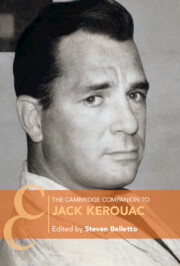Book contents
- The Cambridge Companion to Jack Kerouac
- The Cambridge Companion to Jack Kerouac
- Copyright page
- Contents
- Notes on Contributors
- A Kerouac Chronology
- Additional material
- Introduction
- Chapter 1 Kerouac’s Concept of His Duluoz Legend
- Chapter 2 Kerouac and the Profession of Authorship
- Chapter 3 Truth in Confession
- Chapter 4 The Textuality of Performance
- Chapter 5 The Spontaneous Aesthetic in The Subterraneans
- Chapter 6 Kerouac and the 1950s
- Chapter 7 The Impact of On the Road on the 1960s Counterculture
- Chapter 8 Vanity of Duluoz and the 1960s
- Chapter 9 Late Kerouac, or the Conflicted “King of the Beatniks”
- Chapter 10 Visions of Cody as Metafiction
- Chapter 11 Making the Past Present
- Chapter 12 Spun Rhythms
- Chapter 13 Kerouac’s Representations of Women
- Chapter 14 Kerouac and Blackness
- Chapter 15 Kerouac, Multilingualism, and Global Culture
- Chapter 16 The Two Phases of Jack Kerouac’s American Buddhism
- Chapter 17 Jack Kerouac’s Ambivalences as an Environmental Writer
- Chapter 18 The Essentials of Archival Prose
- Further Reading
- Index
- Cambridge Companions To …
Chapter 13 - Kerouac’s Representations of Women
Published online by Cambridge University Press: 31 October 2024
- The Cambridge Companion to Jack Kerouac
- The Cambridge Companion to Jack Kerouac
- Copyright page
- Contents
- Notes on Contributors
- A Kerouac Chronology
- Additional material
- Introduction
- Chapter 1 Kerouac’s Concept of His Duluoz Legend
- Chapter 2 Kerouac and the Profession of Authorship
- Chapter 3 Truth in Confession
- Chapter 4 The Textuality of Performance
- Chapter 5 The Spontaneous Aesthetic in The Subterraneans
- Chapter 6 Kerouac and the 1950s
- Chapter 7 The Impact of On the Road on the 1960s Counterculture
- Chapter 8 Vanity of Duluoz and the 1960s
- Chapter 9 Late Kerouac, or the Conflicted “King of the Beatniks”
- Chapter 10 Visions of Cody as Metafiction
- Chapter 11 Making the Past Present
- Chapter 12 Spun Rhythms
- Chapter 13 Kerouac’s Representations of Women
- Chapter 14 Kerouac and Blackness
- Chapter 15 Kerouac, Multilingualism, and Global Culture
- Chapter 16 The Two Phases of Jack Kerouac’s American Buddhism
- Chapter 17 Jack Kerouac’s Ambivalences as an Environmental Writer
- Chapter 18 The Essentials of Archival Prose
- Further Reading
- Index
- Cambridge Companions To …
Summary
Women figure prominently in Kerouac’s work, from novels explicitly about women he had encountered in his life (Maggie Cassidy and Tristessa), to short stories like “Good Blonde,” to the lengthy, often lyrical passages about women in The Subterraneans and On the Road. This chapter explores Kerouac’s controversial representations of women, which are often sexist, misogynist, essentialist, racist. Women in Kerouac’s works, even at their most indelible and dramatic, are, as the Beat writer Joyce Johnson termed them, “minor characters”; they catalyze or support action, struggle for recognition, then disappear from the story. Even when the female characters are presumptively protagonists, as in Maggie Cassidy or Tristessa or “Good Blonde,” they are still not much more than objects of narrative delectation or vehicles for emotional expression.
Keywords
- Type
- Chapter
- Information
- The Cambridge Companion to Jack Kerouac , pp. 178 - 191Publisher: Cambridge University PressPrint publication year: 2024

